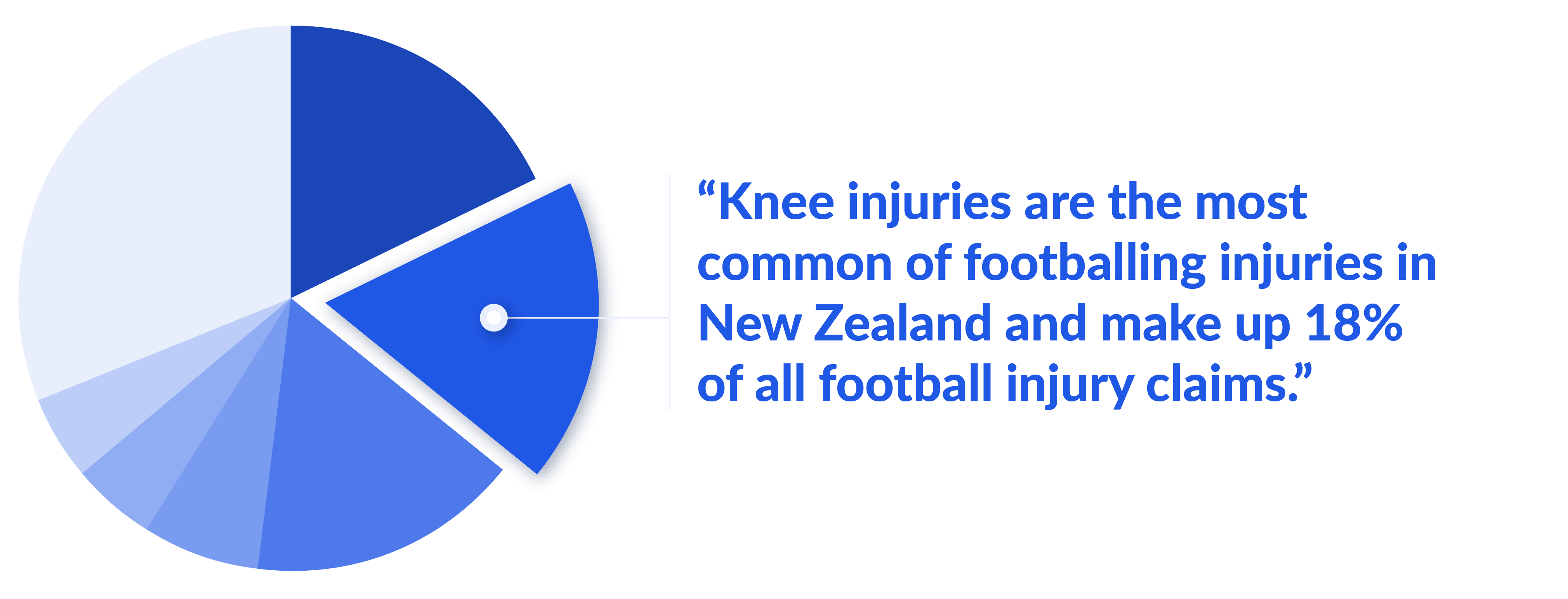Injury Management
See how the most common and debilitating injuries in football impact our game and what you can do to help your players return to play more effectively.

Ankle
Description
As football is a lower-extremity sport, the most common injury site in a football player is the ankle. The ankle is one common area that can sustain injury if we do not prioritise our preparation and recovery. Inadequate warm up preparation, inadequate training, fatigue (both acute and chronic), and poor recovery from previous injury are all factors that can contribute to injury that we can influence.
The most common type of ankle injury is a sprain, while more severe injuries such as fractures, ligament tears and cartilage damage can also occur. Striking a ball, changing direction, and landing while receiving body contact, are all common ways in which someone might injure their ankle.
Initial Steps
You can treat a minor ankle injury at home by following the P.O.L.I.C.E method.
For the first few days after your injury, Protect the injured area, ensure you provide Optimal Loading, Ice it, Compress it, and Elevate it.
If you suspect your injury is severe or if swelling and bruising persists, make an appointment with your doctor, physiotherapist, or go to the emergency department. The following symptoms may be a sign of a severe injury that requires professional care:
- severe swelling and pain
- visible deformities, such as large lumps or limbs bent at strange angles
- popping or crunching sounds when you move the injured area
- inability to support any weight with the injured area
- instability in a joint
- trouble breathing
- dizziness
- fever
You should also contact a medical professional if you have an injury that seems minor but doesn’t improve with home treatment.

Ankle Injury Prevention
Your first line of defence against ankle injury is an effective warm up. The gradual progression in intensity as well as exposure to wide variety of movements within a warmup gives your body the opportunity to perform movements in a controlled manner. Therefore, when we compete in football, which is more chaotic in nature, and we are reactive to opposition and the game, our body is prepared.
Further, proprioception exercises should be included in our warmup and can be done outside of the warmup to further reduce the risk of injury. Anything where we are jumping and landing, balancing on one leg, or challenging our single leg stability strengthens all the musculature in the lower leg as well as those which provide security to our ankle.

Knee
Description
ACL - The anterior cruciate ligament helps to provide stability during movements of rapid changes of direction, pivoting, and landing. An injury to the ACL is most commonly non-contact (e.g., change in direction), although some ACL injuries can occur from contact (e.g., blow to the knee). A “pop” or “snap” sound is sometimes heard, but not always. Often, a player will experience pain and swelling to the area and will not be able to continue play.
Injuries to this ligament may result in the knee feeling loose or unstable. Surgical reconstruction followed by extensive rehabilitation is the traditional treatment. However, there is still the non-surgical option to treat the injury with rehabilitation, allowing other structures (muscular control and balance) to take over the job of the ACL.
Initial Steps
- Players should consult with a physician or sport physician to determine the severity of the knee injury. An MRI and other tests may be used to help diagnose the injury.
- Initially, the goal is to reduce swelling and control pain. Pain relief, such as anti-inflammatory drugs (NSAID), may be needed, in addition to ice.
- Players will undergo pre-operative exercises to prepare the knee and surrounding muscles for rehabilitation following surgery.
- Players who undergo non-operative treatment may work with a sport physician or physiotherapist and follow a rehabilitation protocol.
- Ongoing care and rehabilitation should be led and guided by your sport physician or physiotherapist before returning to training.
Statistics

- ACL injuries present a large cost to the healthcare system, more than $40 million per year in New Zealand.
- Female footballers are 8-9 times more likely to sustain an ACL injury
- It can take up to 9-12 months to return to the same level of play after an ACL tear
- Players that have ruptured their ACL are at a 30% higher risk to re-rupture their ACL for the remainder of their lifetime
Knee (ACL) Injury Prevention
Completing evidence-based warmups and exercise programmes (like the 11+) can reduce the risk for ACL injuries by over 50%. Components of these training programmes may include:
- Correct technique for all prevention exercises is critical – coach feedback will improve the effectiveness of the programme
- Performing exercises a minimum of 2 x per week is essential to gaining results
- Starting in the off-season, continue through pre-season and continue throughout the year – Compliance and consistency is key!
- Monitor your health and wellbeing and ensure you’re not overtraining. Find out more here

Hamstring
Description
The “hamstrings” are a group of muscle located down the back of your thigh. They’re a major muscle group involved in multiple football actions; primarily - sprinting and running, jumping, and striking the ball. Not only are they involved in these key footballing movements, but they are major players, and their strength is essential in order to execute these actions well.
The most common cause of hamstring injury is when the muscle extends quickly or beyond its end range, resulting in damage to the muscle fibres of the hamstrings (often a tear.) Common examples when you may see a hamstring injury occur could be; during sprinting (as the athlete extends their leg out and forward), lunging for the ball (again, extending the leg out quickly), or when striking the ball (as the leg moves into end range at the end of the strike.) Often, we see this happen near the later stages of a game when muscles are fatigued or sometimes near the start/restart due to insufficient warming up of the hamstrings.
Initial Steps
You can treat a minor hamstring injury at home by following the P.O.L.I.C.E method.
For the first few days after your injury, Protect the injured area, ensure you provide Optimal Loading, Ice it, Compress it, and Elevate it.
If you suspect your injury is severe or if swelling and bruising persists, make an appointment with your doctor, physiotherapist, or go to the emergency department. The following symptoms may be a sign of a severe injury that requires professional care:
- severe swelling and pain
- visible deformities, such as large lumps
- popping or crunching sounds when you move the injured area
- inability to support any weight with the injured area
- instability in a joint
- trouble breathing
- dizziness
- fever
You should also contact a medical professional if you have an injury that seems minor but doesn’t improve with home treatment.

Hamstring Injury Prevention
We need to always ensure our body is ready to complete the physical demands of the game before we train or play. That is, we need to warm up! An effective warm up gradually increases in intensity and prepares the body for the movements it is about to complete. Our ‘Gold standard’ 11+ warmup is a scientifically validated example of a warmup that is effective in both preparation and injury prevention.
In addition to this, hamstring injury prevention should focus on ‘getting strong through extension’ as this is the common cause of injury as described above. We want to make sure that we can extend our hamstrings (sprint, jump, strike the ball) for the full 90 minutes with strength and quality. This will ensure that not only do we stay healthy and on the pitch, but key footballing actions will be performed with high quality.
The most common example of a hamstring strengthening exercise that works your muscles through full range is the Nordic Hamstring Curl. As you slowly lower, your hamstrings work to slow your fall. As you get lower to the ground, more and more fibres along the hamstrings are recruited to control this fall. Working to get stronger and fall further, or, working on the number of repetitions you can successfully fall all the way will help prepare your hamstrings for trainings and games!
Other exercises you can perform to minimise the risk of hamstring injury:

Concussion
Description
Sport-related concussion is a traumatic brain injury caused by a direct blow to the head, neck or body resulting in an impulsive force being transmitted to the brain that occurs in sports and exercise-related activities.
(Consensus statement on concussions in sport: The 6th International Conference on Concussion in Sport – Amsterdam, October 2022)
Concussion is a brain injury that affects the function of the brain and the person and may, or may not, result in a loss of consciousness. There are several important features to highlight including:
- A concussion is not always caused by a direct hit to the head. It may be caused by a direct hit to the head, face, neck, or elsewhere on the body with an ‘impulse’ force transmitted to the head.
- Only 10% of concussions present with a loss of consciousness.
- Concussions typically result in the rapid onset of short-lived impairment of neurological (brain cognition) function that resolves spontaneously.
Concussion and head injuries are everyone's responsibility. Coaches, players, clubs, and officials need to act in the best interest of player safety and welfare by taking responsibility for the RECOGNITION, REMOVAL & REFERRAL of all players with a suspected concussion or injury, to a medical professional (from a general practice or primary care team). They should then ensure that concussion is appropriately managed as per these guidelines.
Understanding Concussion Management:
View Poster - Understanding the R's
Graduated Return to Play Guideline:
View Poster - NZF Graduated Return to Play Guideline
View our Concussion Coach Player Development module on NZF Learn here - Concussion and Head Injuries
Statistics
- An estimated 35,000 head injuries occur in NZ per year
- 21% of all head injuries in NZ are sustained through sport.
- There is an estimated 1000+ related concussion injuries that go untreated.
- 11% of sports related concussion claimants had multiple concussions within a 2-year period.
- Evidence shows that with repeat concussion, people may experience a decline in general health and quality of life up to 10 years following injury.
Concussion Prevention
- Following the laws of the game will help keep players safe from most injury types. Avoid gameplay that puts you and others at risk.
- Physical conditioning (such as completing strength & conditioning exercises) will prepare your body for the physical demands of the game and increasing resilience to impact on the field.
- Players that return too early to training and competition after a concussion are more susceptible to sustaining another concussion. Follow the return to play guidelines and work with a medical professional to ensure player health and safety.
- Headgear – The use of headgear has not been shown to reduce the incidence of concussion. However, this piece of equipment can reduce soft tissue injuries to the head.
- Research suggests neck strength is thought to prevent concussions. Players with weaker necks are more likely to experience greater head impacts while players with stronger necks can withstand the velocity of a head impact diffusing the hit through the neck muscles. Speak to your physician or physiotherapist for some neck strength exercises.
FAQS
Have more questions? Take a look at our Frequently Asked Questions document here.

 Admin Login
Admin Login